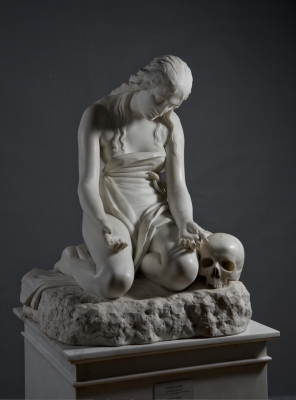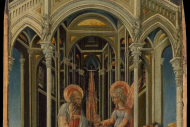Today's Gospel in Art - Feast of Saint Mary Magdalene

Repentant Mary Magdalene, by Antonio Canova 1808 © Hermitage Museum, Saint Petersburg
Gospel of 22nd July 2020 - John 20:1-2,11-18
It was very early on the first day of the week and still dark, when Mary of Magdala came to the tomb. She saw that the stone had been moved away from the tomb and came running to Simon Peter and the other disciple, the one Jesus loved. 'They have taken the Lord out of the tomb' she said 'and we don't know where they have put him.'
Meanwhile Mary stayed outside near the tomb, weeping. Then, still weeping, she stooped to look inside, and saw two angels in white sitting where the body of Jesus had been, one at the head, the other at the feet. They said, 'Woman, why are you weeping?' 'They have taken my Lord away' she replied 'and I don't know where they have put him.' As she said this she turned round and saw Jesus standing there, though she did not recognise him. Jesus said, 'Woman, why are you weeping? Who are you looking for?' Supposing him to be the gardener, she said, 'Sir, if you have taken him away, tell me where you have put him, and I will go and remove him.' Jesus said, 'Mary!' She knew him then and said to him in Hebrew, 'Rabbuni!' - which means Master. Jesus said to her, 'Do not cling to me, because I have not yet ascended to the Father. But go and find the brothers, and tell them: I am ascending to my Father and your Father, to my God and your God.' So Mary of Magdala went and told the disciples that she had seen the Lord and that he had said these things to her.
Reflection on the Neoclassical Sculpture
I saw this neo-classical sculpture for the first time some eight months ago, at an exhibition in Rome about Antonio Canova's work. I thought it was absolutely breath-taking. The Penitent Magdalene, exists in two final versions, one kept in Genoa, and one in St Petersburg. In the Genoa version which I saw, Mary Magdalene is holding a bronze crucifix, which is poignant, but I do like the version which I am sharing with you, where her drooping hands are simply turned upwards, resting on her legs in an expressing of surrender, repentance and despair. Canova sculpted Mary Magdalene as a young, graceful, beautiful woman dressed as a hermit. The skull at her feet signifies the brevity of earthly existence.
Today is the feast of Saint Mary Magdalene. In 2016 the Congregation for Divine Worship published a new decree, by which the celebration of St. Mary Magdalene was elevated to the level of a feast day. Archbishop Arthur Roche, secretary of the Congregation for Divine Worship, said the following words, which I will leave you with: "On the one hand, she has the honour of being the 'prima testis' to the resurrection of the Lord, the first to see the empty tomb and the first to hear the truth of His resurrection. Christ has a special consideration and mercy for this woman, who shows her love for Him, looking for Him in the garden with anguish and suffering, with 'lacrimas humilitatis', as St. Anselm says. In this sense, I would like to show the difference between the two women present in the garden of Paradise, and in the garden of the Resurrection. The first disseminates death where there was life, and the second proclaims Life from a tomb, the place of death. … Likewise, it is in the garden of resurrection that the Lord says to Mary Magdalene, 'Noli me tangere'. It is an invitation not only to Mary, but also to all the Church, to enter into an experience of faith that overcomes any materialistic appropriation or human understanding of the divine mystery. It has ecclesial importance! It is a good lesson for every disciple of Jesus: do not seek human securities and worldly honours, but faith in the Living and Risen Christ."
LINKS
Today's story - https://christian.art/en/daily-gospel-reading/490
Christian Art - www.christian.art


















